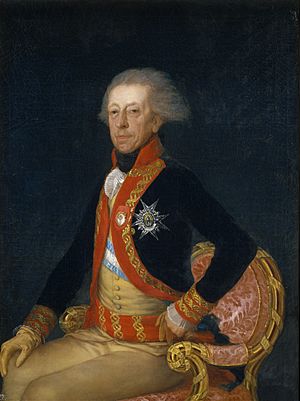Siege of Bellegarde (1793) facts for kids
Quick facts for kids Siege of Bellegarde (1793) |
|||||||
|---|---|---|---|---|---|---|---|
| Part of the War of the Pyrenees | |||||||
 Bellegarde fortress chapel |
|||||||
|
|||||||
| Belligerents | |||||||
| Commanders and leaders | |||||||
| Strength | |||||||
| 1,536, 48 guns | 6,000, 34 guns | ||||||
| Casualties and losses | |||||||
| 1,536 | unknown | ||||||
The Siege of Bellegarde was an important battle that happened between May 23 and June 24, 1793. During this time, a Spanish army, led by Antonio Ricardos, attacked the Fort de Bellegarde. The French soldiers defending the fort, led by Colonel Boisbrulé, eventually surrendered.
Taking control of Fort de Bellegarde was a big win for Spain. It meant they could use a key road through the Pyrenees mountains. This siege was part of the War of the Pyrenees, which was itself a part of the larger French Revolutionary Wars. Fort de Bellegarde is located on a high point overlooking the town of Le Perthus, right near the border.
Contents
Why Fort Bellegarde Was Important
King Louis XIV of France had Fort de Bellegarde built after 1678. The famous military engineer Sébastien de Vauban designed this strong stone fortress. Its main job was to protect the Col du Perthus mountain pass. This pass is about 305 meters (1,000 feet) high and is the most important route from Spain into France in the eastern Pyrenees. Vauban himself said, "Nothing overlooks this place," meaning the fort was built on the highest ground around.
When Spain and revolutionary France went to war in April 1793, the Spanish commander, Captain General Antonio Ricardos, faced a challenge. Fort de Bellegarde controlled the main road into France. Ricardos knew he had to capture it to use the road for his army's supplies.
Spanish Army's Plan
To start, Ricardos led about 4,500 soldiers around 20 kilometers (12 miles) southwest of the fort. They marched into the village of Saint-Laurent-de-Cerdans. This was the first fight of the war, and the Spanish quickly pushed out the 400 French defenders.
Ricardos continued his attack, moving his 4,400 troops to the town of Céret on the Tech River. Here, 800 French regular soldiers and 1,000 National Guards with four cannons panicked and ran away. Many French soldiers were killed or drowned trying to cross the river. Ricardos reported only 17 of his men were wounded. During these early battles, the Spanish also placed a small group of soldiers near Bellegarde. This was to stop the French garrison from attacking Spanish supply convoys.
Setting the Stage for the Siege
After taking Céret, Ricardos's army was almost behind Bellegarde. He received more soldiers and moved northeast toward Trouillas. There, his 7,000 Spanish troops met the Army of the Eastern Pyrenees, led by General of Division Louis-Charles de Flers.
At the Battle of Mas Deu on May 19, Ricardos defeated de Flers. The French lost many soldiers and some cannons. The French soldiers were discouraged and retreated north to Perpignan, the capital city. Some of their National Guard soldiers even refused to fight and had to be sent home. Instead of pushing on to Perpignan, Ricardos decided to turn back. He needed to besiege Bellegarde because it was right next to his main supply route back to Barcelona.
The Siege of Bellegarde Begins
The siege of Fort de Bellegarde started on May 23. Inside the fort were 1,536 French soldiers. They had a lot of firepower, including at least 41 cannons and seven mortars.
While the main siege was happening, Spanish General Antonio Ricardos also attacked two other French forts near the Tech River. These forts were connected to Fort de Bellegarde's defense. Fort les Bains, about 16 kilometers (10 miles) northwest, was attacked on May 23. Its 350 defenders surrendered on June 3 after being bombed. Fort de la Garde, about 31 kilometers (19 miles) west, had 200 defenders. They gave up on June 5 after their water supply was cut off.
For several weeks, the Spanish used their powerful siege guns to pound Fort de Bellegarde. They kept firing until they made a large hole in the main wall. By this time, 42 of the 50 French cannons inside the fort were broken. Facing a direct attack with their defenses ruined, Colonel Boisbrulé and his remaining soldiers formally surrendered Bellegarde on June 24. The French soldiers who were left became prisoners of war. During the month-long siege, the French lost 30 soldiers killed, 56 wounded, and 1,450 captured. The number of Spanish losses is not known.
What Happened Next
With Fort de Bellegarde now under Spanish control, Ricardos's army could use the Col de La Pertus pass to get supplies. Ricardos then tried to attack Roussillon's capital city, Perpignan. However, he was strongly pushed back at the Battle of Perpignan on July 17, 1793.
General de Flers's French army, with 12,000 troops, lost 800 soldiers. They also lost one cannon, and 600 soldiers ran away. The Spanish, with 15,000 soldiers, lost about 1,000. De Flers had used the month that Ricardos spent attacking Bellegarde to train his new soldiers. He also built strong defenses around Perpignan. The French pushed back Ricardos again in the Battle of Peyrestortes on September 17. However, the Spanish won against their opponents in the Battle of Truillas five days later.


